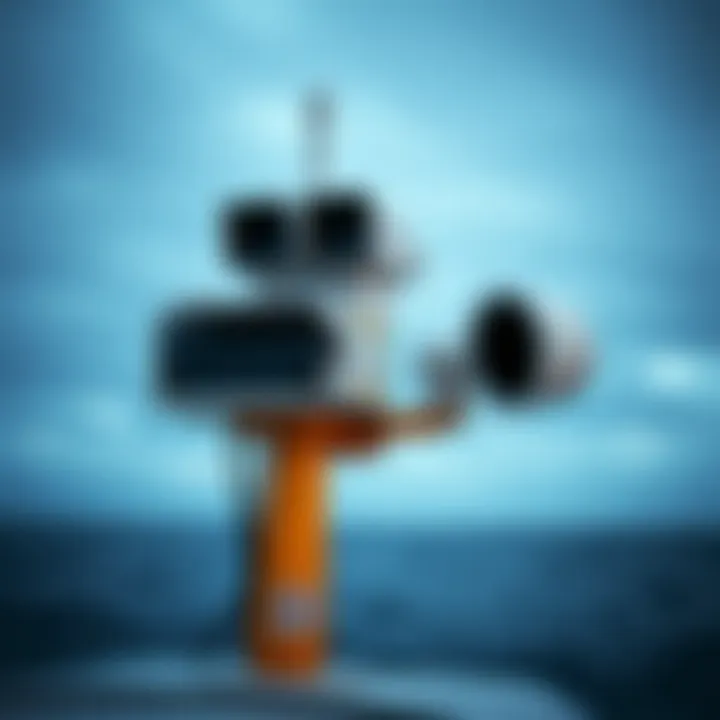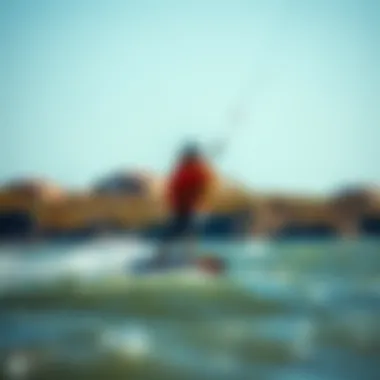Exploring Two Harbors Weather Radar Systems


Intro
Understanding the weather is essential, especially for those looking to enjoy outdoor activities like kiteboarding or navigating coastal waters. The weather radar systems deployed in Two Harbors offer a compelling lens through which to interpret atmospheric conditions. These sophisticated devices are designed to collect, analyze, and disseminate data about the weather, making them invaluable for local adventurers and marine navigators alike.
In this article, we'll journey through the inner workings of Two Harbors' weather radar systems. We will uncover how they operate, the technology behind them, and their practical usage in both maritime safety and kiteboarding activities. Understanding how to interpret radar data and its implications for safety protocol is critical in enhancing our interaction with the elements. This narrative aims to serve not only meteorology enthusiasts but also those who find joy in outdoor sports, specifically kiteboarding.
As we dive deeper into the various facets of weather radar systems, we will also discuss essential gear for kiteboarding, the skills required to harness the wind effectively, and how to apply radar information to improve safety margins during your adventures.
Preamble to Two Harbors Weather Radar
Understanding the Two Harbors Weather Radar is key for anyone looking to gain insights into the local weather patterns, especially for activities such as kiteboarding and maritime navigation. This article presents a detailed examination of this radar system, highlighting its critical role in enhancing safety and optimizing outdoor adventures in the region.
The Importance of Weather Radar
Weather radar plays an indispensable role in our ability to anticipate and respond to changing atmospheric conditions. These systems are not just gadgets; they are the eyes in the sky, monotoring storms and precipitation in real-time. With accurate data, enthusiasts and professionals alike can make informed decisions, minimizing weather-related risks. For instance, kiteboarders can assess wind patterns and strength, avoiding dangerous conditions, while sailors can navigate safely through changing weather.
Additionally, communities rely on weather radar to issue timely alerts about severe weather, like tornadoes or heavy rainfall, ensuring the safety of residents and visitors. This technology forms the backbone of meteorological services, proving that informed predictions can save lives and enhance recreational experiences.
"Weather radar systems transform raw meteorological data into usable information, guiding decisions for safety and enjoyment."
Overview of Two Harbors Location
Situated along the North Shore of Lake Superior, Two Harbors is a unique locale characterized by its stunning natural vistas and maritime activities. This area is neither too densely populated nor too remote, presenting the right blend for those seeking adventure while still requiring reliable weather reporting. The town's position, ballooned by waters on one side and the lush forests on the other, means that local weather can shift swiftly and unexpectedly.
Two Harbors serves as a hub for outdoor enthusiasts. With its proximity to the lake, the winds can create perfect conditions for kiteboarding and sailing, yet they can also spawn sudden storms. Understanding the local radar data becomes particularly crucial for planning the day’s outdoor activities. Whether you’re sailing across the wave tips or launching into the wind with your kite, having a keen watch on the Two Harbors weather radar means being as savvy as can be windows down on the highway to adventure.
This radar system not only aids in assessment for kiteboarding but also benefits local fishermen and maritime traffic, contributing to safer and more enjoyable experiences on the water. Its integration into community life underscores the necessity for a reliable tool that interprets nature's whims and allows for proactive decisions.
Understanding Radar Technology
Understanding radar technology is paramount in grasping how Two Harbors weather radar systems operate effectively. This technology offers a window into atmospheric conditions, providing crucial data that can impact safety and decision-making for various activities, including maritime navigation and kiteboarding. The fundamental purpose of radar lies in its ability to detect, track, and analyze weather patterns. By comprehending radar technology, individuals can appreciate its relevance in daily life, particularly for those who engage in outdoor activities.
Basic Principles of Radar
At its core, radar technology functions on a simple principle: it transmits electromagnetic waves that bounce back from objects, thereby enabling the detection and location of these objects. When discussing weather radar specifically, the focus is often on how these waves interact with precipitation. Here’s how it usually works:
- Transmission: The radar system sends out a pulse of energy into the atmosphere.
- Reflection: When this energy encounters precipitation, it gets scattered in various directions.
- Reception: The radar receives the scattered signals, which provides information about the intensity, location, and movement of the precipitation.
This basic process underpins all radar technology, with variations arising based on different types of radar systems employed.
Types of Radar Systems
There are several distinct radar systems, each serving unique purposes. Understanding the differences can help clarify their individual contributions to Two Harbors weather monitoring.
Pulse Radar
Pulse radar operates by sending brief bursts of energy into the atmosphere. This technique allows for capturing clear snapshots of weather conditions at specific intervals. A notable characteristic of pulse radar is its ability to measure distances effectively, making it particularly suitable for tracking rainfall intensity and movement.
- Unique Feature: The quick pulses come in handy for identifying rapidly changing weather patterns, making it a reliable tool in forecasting.
- Advantages: Its efficiency in distance measurement means that it can cover a broad area with fewer resources.
- Disadvantages: However, it might struggle under certain conditions, such as light rainfall, where signals could be faint and less informative.
Continuous Wave Radar


Continuous wave radar presents a different approach by emitting a constant signal rather than pulses. This system excels in detecting motion. Its primary characteristic is that it measures the Doppler effect caused by moving objects, allowing for detailed data on the speed and direction of precipitation.
- Unique Feature: This constant transmission makes it adept at tracking slowly moving weather systems and allows for sustained monitoring of storm systems.
- Advantages: The ability to measure speed and direction with accuracy is invaluable for understanding severe weather.
- Disadvantages: On the flip side, it can be less effective in determining the precise distance of an object, which may reduce its overall utility in some situations.
Frequency Modulated Continuous Wave Radar
Lastly, frequency modulated continuous wave radar takes the continuous wave concept a step further by varying the frequency of the emitted signals. This allows for enhanced resolution compared to standard continuous wave radar.
- Unique Feature: Its signal processing techniques help in distinguishing between various types of precipitation, like rain, snow, or hail.
- Advantages: This high-resolution ability can lead to more accurate weather forecasts, crucial for kiteboarding and other outdoor activities where weather conditions can change rapidly.
- Disadvantages: However, its complexity can pose challenges in operational maintenance compared to simpler radar systems.
Operational Functioning of Two Harbors Weather Radar
The operational functioning of the Two Harbors Weather Radar is pivotal to understanding how it serves its diverse array of applications. This topic stands as a backbone of the article, tying together various aspects of weather forecasting, maritime safety, and recreational activities like kiteboarding. The efficient operation of weather radar not only enhances the accuracy of weather forecasts but also plays a crucial role in ensuring safety for the many individuals who rely on this technology.
Data Acquisition Process
At the heart of the Two Harbors Weather Radar is its data acquisition process, which is vital for gathering real-time information on atmospheric conditions. The radar utilizes radio waves to detect precipitation and other meteorological phenomena. Essentially, when the radar emits a pulse, it travels through the atmosphere and is reflected back by raindrops or other moisture particles. The time it takes for the signal to return is recorded, allowing meteorologists to measure distance and intensity.
- Pulse Emission: The radar sends out energy pulses at regular intervals. These pulses can be compared to throwing a stone into still water and observing the ripples. The returning signal indicates both the range and strength of the rain.
- Reflectivity Measurement: By measuring how much radar energy is returned, radars can quantify precipitation. This is crucial for gauge dry vs. wet conditions that impact activities like kiteboarding, where wind and rain conditions are key.
- Updating Data: Modern radars can update their data as frequently as every few minutes. This rapid data acquisition is essential for adapting forecasts to quickly changing weather conditions.
The accuracy of this data acquisition process can be a game-changer for kiteboarders and sailors alike, as it helps them make informed decisions about when and where to engage in these outdoor activities.
Signal Processing Techniques
Once data is collected, it undergoes signal processing techniques that transform raw information into usable forecasts. This step ensures precision in the weather radar's outputs and enhances its reliability in predicting weather events.
- Echo Processing: The radar system analyzes the strength and shape of the echo signals returned. Weak echoes may indicate light rain, while stronger signals suggest heavier precipitation. This granularity allows for targeted forecasts
- Doppler Effect Utilization: Doppler radar technology steps in here, measuring changes in the frequency of echoes. This technique helps in gauging wind speeds and directions, vital for not just forecasts but for assessing storm intensity as well.
- Illustrative Display: The processed radar data is then represented graphically on screens in meteorological centers. The readable data visualizes weather patterns like fronts and storms, guiding meteorologists and ensuring that accurate information gets to the public in real-time.
- Integration with Other Systems: Finally, the processed signals often get fed into modeling systems that integrate data from other sources. This step is key for producing comprehensive weather forecasts. For instance, a synergy between ground data and radar information enhances reliability when predicting conditions for kiteboarding.
Understanding these techniques emphasizes the sophistication of the Two Harbors Weather Radar's operational functioning, laying the groundwork for accurate weather forecasting and enhanced safety for outdoor enthusiasts. The insights drawn from the operational aspects serve not only those who seek accurate kiteboarding conditions, but also broader maritime safety, emphasizing the radar's integral role in community well-being.
Applications and Benefits of Two Harbors Weather Radar
The Two Harbors weather radar plays a pivotal role in a variety of domains that extend beyond basic weather prediction. Understanding its applications and benefits not only showcases the technology's significance but also highlights how this regional tool contributes to both safety and enjoyment in daily life. By merging local weather insights with advanced radar technology, this system makes considerable strides in enhancing forecasting accuracy, ensuring maritime safety, and even influencing outdoor recreation.
Weather Forecasting
First and foremost, weather forecasting stands as a primary application of the Two Harbors weather radar. With its precise tracking capabilities, the radar allows meteorologists to observe atmospheric conditions in real-time. When severe weather looms, such as thunderstorms or heavy rain, the radar pins down storm intensity and movement with impressive accuracy.
- Predictive Analysis: The ability to predict local weather events can make the difference between smooth sailing and getting caught in a storm for both residents and travelers.
- Localized Insights: Standard forecasts, often delivered at a broader scale, miss the fine details. Two Harbors radar can relay specific local conditions, ensuring that the community has the most relevant information at their fingertips.
- Data Visualization: Analyzing radar data is essential. Visual representations, such as Doppler radar images, allow users to quickly grasp changing weather patterns, leading to better decision-making.
This accurate and timely weather forecasting is crucial for diverse sectors, including agriculture, emergency services, and outdoor planning.
Maritime Safety and Navigation
Another critical aspect of the Two Harbors weather radar is its contribution to maritime safety and navigation. Given its proximity to the water, this radar system is indispensable for both local fishermen and commercial vessels traversing the region.
- Collision Avoidance: By providing up-to-date data on weather conditions and potential hazards, the radar helps seafarers avoid dangerous situations, thus reducing the risk of accidents.
- Navigational Aid: Understanding wind patterns and wave heights is essential for safe navigation. The radar utilizes advanced techniques to estimate these factors, arming mariners with knowledge needed to chart a safe course.
- Alerts for Severe Conditions: During bad weather, automatic alerts generated by the radar system notify nearby vessels of hazardous conditions. This technology is vital for guiding boats during storms and preventing distress situations at sea.
Through these functionalities, the Two Harbors weather radar significantly enhances maritime operations, ensuring safer travels across the water.
Impact on Kiteboarding Activities
Finally, the influence of the Two Harbors weather radar extends to recreational activities such as kiteboarding. For enthusiasts of this exhilarating sport, understanding wind patterns and weather conditions is key to an enjoyable experience.


- Wind Forecasts: Kiteboarders rely heavily on wind conditions. Accurate readings from the radar enable riders to predict when the wind will be strong enough, or too gusty for safe kiteboarding.
- Real-time Updates: As conditions can change in the blink of an eye, real-time updates from the radar ensure kiteboarders are well-informed, allowing them to maximize their time on the water while remaining safe.
- Community Engagement: Local kiteboarding communities often gather around these insights shared through local resources. Social media updates, coupled with radar data, empower kiteboarders to plan their outings more effectively, fostering a sense of community.
Data Interpretation and Reporting
Importance of Data Interpretation and Reporting in Weather Radar Systems
Understanding data interpretation and reporting is crucial to fully grasp the potential of weather radar systems, such as those in Two Harbors. These radars do not merely exhibit figures and blips on a screen; they present invaluable information for various sectors, including meteorology, maritime navigation, and sporting activities, particularly kiteboarding. The ability to interpret the collected data not only enhances users' safety but also empowers them to make informed decisions.
The functionality of radar data goes beyond what meets the eye. It revolves around translating signals, which in turn represent atmospheric conditions. By grasping how to accurately read radar outputs, readers can better predict weather changes, assess storm intensity, and even gain insight into how weather fronts might affect their activities on the water.
The importance of a solid reporting practice cannot be overstated. Accurate and timely weather reports derived from radar data can be the difference between safe navigation and unfortunate mishaps in unpredictable weather. Sailors, for instance, must be quick to interpret these reports to adapt their routes, ensuring their safety while navigating the often turbulent waters off Two Harbors.
Reading Weather Radar Data
Reading weather radar data might seem daunting at first glance, but breaking it down can make it a more manageable task. Typically, radar displays show precipitation intensity, storm movement, and even wind velocity through different color-coded areas and symbols. Here’s how to decode some of the essential elements of radar imagery:
- Reflectivity: This indicates the intensity of precipitation. Higher reflectivity suggests heavier rain or snow, typically shown in shades like orange, red, or green.
- Doppler Information: Doppler radar data can help detect wind patterns, allowing users to see what direction storms are moving. This can be particularly helpful for kiteboarders planning their sessions.
- Echoes: Different echoes represent different types of precipitation, whether rain, snow, or possibly hail. Understanding echo shapes and sizes can help predict storm developments.
When analyzing the data, it’s important to consider the time factor as well. Weather conditions aren’t static, and radar data should be interpreted in the context of real-time updates. Those who regularly interact with weather radar can confidently predict how impending weather might impact their plans.
Understanding Weather Patterns
Just as a skilled chef can taste the ingredients in a dish, a proficient kiteboarder can sense the subtle cues presented in weather patterns. Recognizing these patterns can significantly influence a person's enjoyment and safety when engaging in outdoor activities. There are a few key weather indicators to keep in mind:
- Storm Systems: Identifying frontal boundaries and low-pressure systems is vital to understanding what kind of weather is on the horizon. Observing how these systems move across the radar can prepare observers for impending storms.
- Temperature Changes: Fluctuations in temperature can lead to shifts in wind speed and direction, another vital component for kiteboarders. By keeping an eye on these changes, enthusiasts can optimize their time on the water.
- Humidity Levels: The moisture content in the air often contributes to thunderstorm development. Familiarity with humidity trends can enable kiteboarders to discern when conditions are right for both flying a kite and enjoying a ride.
In summary, understanding how to effectively read and report on weather radar data equips outdoor enthusiasts with vital intelligence. With the correct tools and approach, kiteboarders and mariners alike can navigate the complexities of Two Harbors' weather, ensuring they remain informed and safe while pursuing their passions.
"Knowledge is power. When you know the weather, nothing can catch you by surprise."
For further insight, consider visiting The National Weather Service or NOAA for professional guidance on weather radar interpretation.
Challenges and Limitations
Understanding the challenges and limitations of weather radar systems is crucial for grasping their role in weather forecasting, maritime safety, and outdoor activities like kiteboarding. While Two Harbors' weather radar offers a wealth of information, recognizing its constraints helps users make informed decisions, particularly in changing weather conditions. The radar's capabilities, while impressive, come with inherent challenges that can influence data accuracy and reliability.
Environmental Factors Affecting Radar Performance
Several environmental variables can influence how effectively radar systems operate. For instance, precipitation plays a significant role in radar performance. Heavy rainfall can create attenuation, which weakens the radar signals, causing unclear images of weather patterns. Additionally, fog, snow, and even atmospheric temperature inversions can interfere with accurate data transmission.
To illustrate, consider a scenario where kiteboarders are ready to hit the waves but are unaware of an incoming fog bank. The radar might struggle to provide precise information on visibility, leading to dangerous conditions on the water. Hence, understanding these environmental factors is essential for outdoor enthusiasts who rely on accurate weather forecasts.
Key environmental influences include:
- Precipitation Type: Rain, snow, and sleet all affect signal strength differently.
- Topography: Mountains and buildings can hinder radar waves, creating shadowing effects.
- Atmospheric Conditions: Variations in temperature and humidity can distort radar readings.
By acknowledging these limitations, both kiteboarders and navigators can better plan their activities, considering possible discrepancies in radar information.
Technological Constraints
Aside from environmental factors, technological limitations also affect the reliability and effectiveness of weather radar systems. For one, the radar is limited to detecting only certain types of weather phenomena, meaning that it might miss out on crucial information related to smaller, localized storms or less distinct weather changes.
In the realm of Two Harbors, lacking real-time data integration can pose a challenge. The technology used in weather radar can sometimes lag behind real weather events, creating a gap in accurate forecasts. Additionally, the resolution of the radar can have its shortfalls; low-resolution images might not capture nuanced shifts in weather patterns, which can be critical for those who plan outdoor activities.


The technical constraints include:
- Resolution Limitations: Roughly speaking, lower resolution might miss important storm details.
- Scanning Frequency: Long intervals between scans can delay updates on rapidly changing weather.
- Dependence on External Data: Without updates from other systems, the radar can provide incomplete pictures.
While these limitations do not wholly undermine the value of Two Harbors' radar data, they certainly necessitate caution. Users must be vigilant and complement radar data with other weather sources for the best possible preparation and safety.
"Knowing the radar's limitations improves understanding and enhances safety, be it in navigating waters or planning a day on the kitesurfing beach."
In sum, navigating the world of weather radar in Two Harbors means balancing the radar's strengths against its environmental and technological limitations. Staying informed about these factors is essential for anyone seeking to maximize the safety and enjoyment of their outdoor experiences.
The Future of Weather Radar Systems
As we stand at the crossroads of technology and meteorology, it becomes increasingly vital to explore where the future of weather radar systems is headed. The advancements in this field not only promise enhanced predictive capabilities but also hold significant implications for various industries, including maritime navigation and outdoor sports like kiteboarding. The significance of ongoing research cannot be overstated, as it may redefine how we interpret weather data and respond to environmental challenges in a timely manner.
Emerging Technologies in Meteorology
Emerging technologies are reshaping meteorology in profound ways. For example, the integration of artificial intelligence in weather radar systems enables faster data analysis and improves prediction accuracy. Algorithms that learn from past weather patterns can provide unprecedented insights, thus minimizing errors in forecasting. Combining these robust data sources ensures that weather radar systems remain relevant and effective in an era where climate variability is a pressing concern.
Furthermore, next-generation radar technologies employ phased array systems, which allow for quicker updates on weather conditions. This rapid processing can lead to real-time alerting, dramatically improving response times for hazardous weather phenomena. Investors and governments are increasingly recognizing the potential of these technologies, thus accelerating development and research in the field.
Integration with Other Technologies
Satellite Systems
Satellite systems play a crucial role in modern meteorology, providing comprehensive coverage that complements weather radar data. They provide a bird's-eye view of atmospheric conditions, and their ability to capture data on a global scale makes them invaluable. The high-resolution imagery offered by these satellites allows meteorologists to track storms and weather fronts much more effectively.
One of the key characteristics of satellite systems is their spatial resolution, which ensures detailed observations of weather phenomena. In articles discussing Two Harbors, leveraging satellite imaging can help kiteboarders and sailors anticipate weather shifts, ultimately enhancing their safety and experience. However, the disadvantage lies in occasional latency; satellite data isn't always real-time, which may limit its effectiveness in extreme conditions like sudden storms.
Advanced Computational Models
Advanced computational models represent another significant aspect of evolving meteorological technology. These models use sophisticated algorithms to simulate the atmosphere, allowing for accurate predictions over longer time horizons. The ability to simulate various conditions and scenarios aids in visualizing potential weather events, thereby equipping forecasters with critical tools for decision-making.
Moreover, the dynamic nature of these models means they are continually refined as new data is fed in from various sources, including weather radar and satellite systems. One advantage is their predictive skill; however, they also require substantial computational resources, which can pose challenges for smaller organizations or regions with limited technology budgets.
As we look toward the future, it's clear that the collaboration between weather radar systems, satellite systems, and computational models will create a more holistic approach to understanding our atmosphere. By fostering innovation in this space, we can ensure that both kiteboarders and maritime professionals are better prepared to navigate the capricious winds of weather.
"Innovation is the calling card of the future. To thrive, we must adapt to emerging technologies and methodologies."
For deeper insights into these advancements, one can consult resources like NASA or NOAA, which frequently publish on meteorological advancements and their applications. The dialogue around these topics continues to evolve, making it essential for enthusiasts and professionals alike to stay informed.
The End
As we wrap up our exploration of Two Harbors Weather Radar, it becomes clear just how vital these systems are not only for local weather predictions but also for activities like maritime navigation and kiteboarding. The comprehensive data gathered by radar enables accurate forecasts which, in turn, have significant implications for safety and enjoyment. With the untamed nature of weather patterns along the Two Harbors coast—where the air can switch from a gentle breeze to a stirring gale in the blink of an eye—having reliable radar data is a game-changer.
Summary of Key Points
In concluding this discussion, several key points merit reiteration:
- Technological Foundations: Weather radar systems are built on advanced technology that allows them to detect and interpret various weather patterns.
- Practical Applications: The data aids in more than just forecasting; it plays a crucial role in ensuring safety for both mariners and outdoor enthusiasts.
- Impact on Kiteboarding: For kiteboarders, the information offered is invaluable; knowing when to ride the wind—and when to retreat—can make all the difference.
- Challenges: Environmental factors and technological limitations are challenges faced by these systems, underscoring the need for continued innovation.
The Significance of Continued Research
The journey doesn’t end here. Continued research into weather radar technology is imperative. As weather becomes increasingly unpredictable due to climate change, enhancing the capabilities of radar systems is essential. Integrating emerging technologies such as machine learning may allow for even greater accuracy in weather predictions. This could benefit not just kiteboarding aficionados, but also vital sectors like agriculture and disaster management, showcasing the far-reaching implications of continued investment in this field.
"The advancements in weather radar systems reflect not just our quest for knowledge but our responsibility to harness this knowledge for safety and improvement in various aspects of life"
Ongoing studies and developments will not only refine existing models but also ensure that Two Harbors remains a safe haven for those who seek adventure. Therefore, fostering a culture of research and adaptation within meteorology is not just a luxury—it’s a necessity.
For those interested in delving deeper into this subject, a wealth of resources is available. Websites such as NWS and NOAA offer valuable data and insights.















